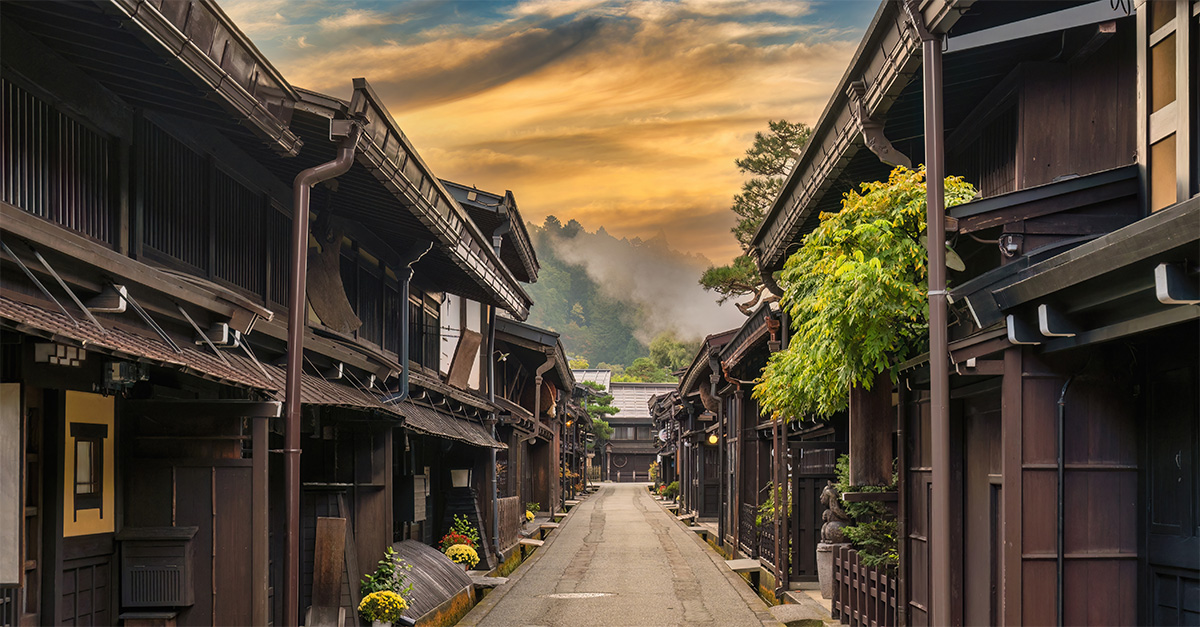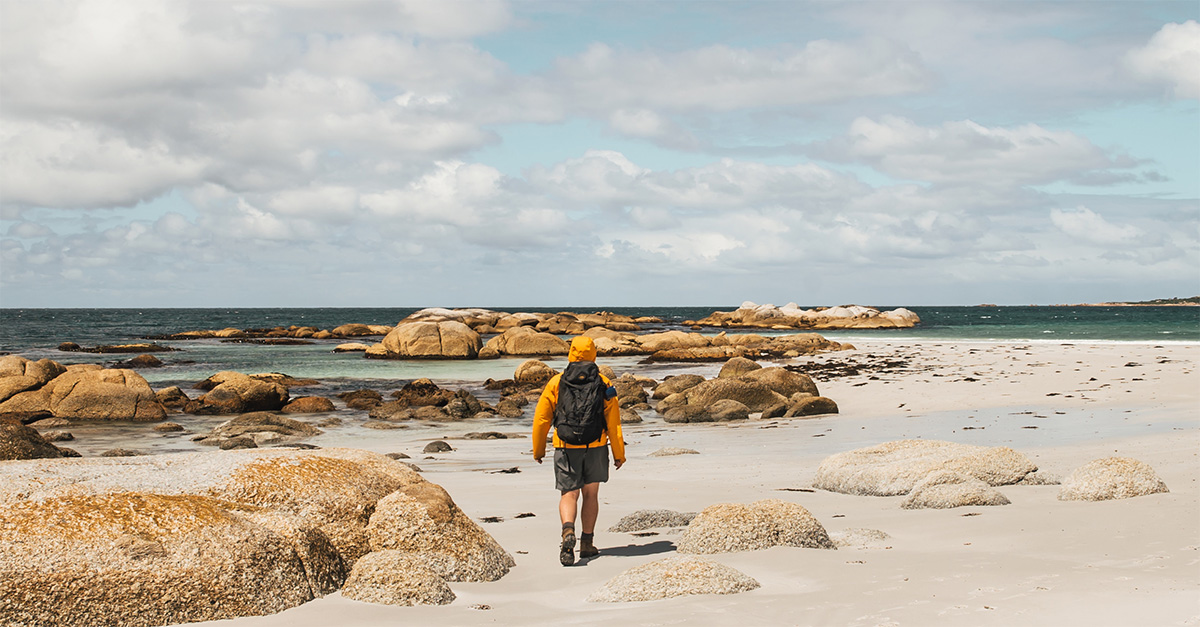Katie Mcgonagle heads halfway to the north pole with an adventure trip to the Arctic archipelago of Svalbard.
Click here to download and save as a PDF.
It’s barely mid-afternoon but already the darkness has settled in around us. The wind whips up swirls of freezing fog that dance across the ice ahead, all but obscuring the tiny red tail light of the snowmobile in front as I press on, mittened hand clutching the accelerator.
I’m no speedster – though zooming across this Arctic wilderness, set halfway between northern Norway and the North Pole, is thrilling, to say the least – but there’s not a moment to lose. We have to reach Svea, our home for the evening, before nightfall.
“Zooming across this Arctic wilderness, set halfway between northern Norway and the North Pole, is thrilling.”
We snake single-file through the snow-covered valley, balaclavas frozen in folds around our faces and the wind biting at any inch of uncovered cheek. It’s 15C below zero, and we’re hundreds of miles above the Arctic Circle in Spitsbergen, the largest island in the remote archipelago of Svalbard.
We carry on, tracing our way between the hulking shadows of the mountains until we finally emerge from the valley, and a distant light from a building comes into view. Even by Svalbard standards, the mining town of Svea (population: zero, though a few hundred people work here on and off across the year) is small. Yet after a day glimpsing nothing but the occasional Svalbard reindeer snuffling through the snow and the odd ruin of a cabin, the comforts of a bar, a restaurant and a warm bed, in the former miners’ quarters at Svea Svalbard, seem positively palatial.
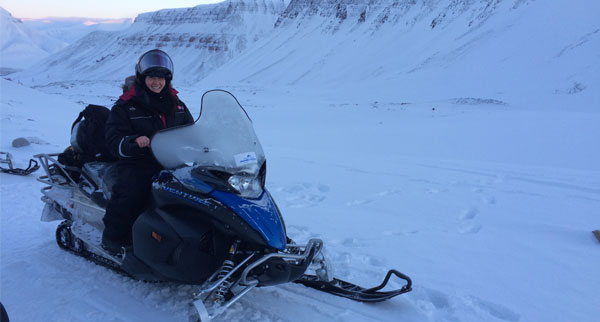
Yet the real fascination of Svea – and Svalbard in general – is in meeting the people who live here and seeing how they’ve adapted to life at the very edge of civilisation. An American expat says with a gleeful smile that it reached 18C last summer – a heatwave, she explains – while another local tells us why people don’t lock their cars or their doors here, in case anyone spots a polar bear on the prowl and is in need of a refuge.
The normal rules simply don’t apply here. In winter, the sun never emerges above the horizon, and in summer, it never sets. You can’t be born and you can’t die here – officially, at least. The permafrost means burial is out of the question, and the hospital isn’t set up for childbirth, so pregnant women must fly to the mainland before their due date, just in case.
“People don’t lock their cars or their doors here, in case anyone spots a polar bear on the prowl and is in need of a refuge.”
There are more polar bears than people, and almost all of the 2,300 residents live in capital Longyearbyen, home to the world’s northernmost university, post office, bank and brewery.
But if this sounds like somewhere that’s closed off to all but Bear Grylls-style explorers, perhaps the most surprising thing is how accessible it is. Hurtigruten Svalbard can trace tourism here back to 1896, and today, it’s easily reached via cruise ship or a three-hour flight from Oslo, putting it well within the grasp of mainstream tourists.
With birdwatching, boat trips and basking under the midnight sun in summer, or snowmobiling, husky sledding and northern lights spotting in winter, there’s plenty to satisfy all adventurers.
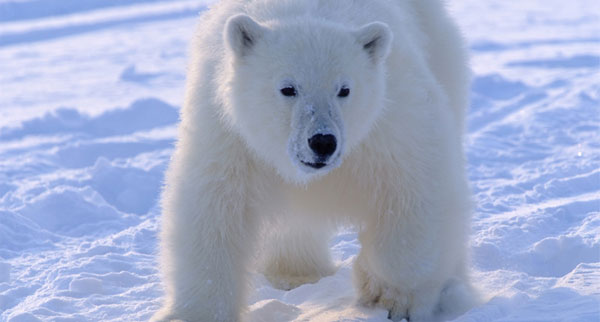
Into the wild
Svea wasn’t the only highlight of our overnight snowmobile safari through the rugged terrain of southwest Spitsbergen. We stopped at the Russian ‘ghost town’ of Coles Bay, once a hub for transporting coal from the nearby mines at Grumant, until it was abandoned in the 1960s.
Some of its buildings are still eerily intact, and while the paint might be peeling and the place in disrepair, there are shelves left stocked with everyday items, and tables with chairs pulled out as though their owners had just stepped out for a moment, and never returned.
“It’s so far below zero here that if you throw boiling water into the air, it instantly turns to ice – cue Instagram videos galore.”
The snow-edged seafront was tranquil, but it paled in comparison with the utter silence we encountered the next morning, when our snowmobiles carried us up the soaring slope of a glacier to a summit so high it was bathed in sunlight, even while the rest of the island was suffused with nothing more than a dusky twilight.
Our guides, who hadn’t seen the sun at ground level since October, basked in the warm pink glow as light glinted off the snow, before showing us a nifty trick: it’s so far below zero here that if you throw boiling water into the air, it instantly turns to ice – cue Instagram videos galore.
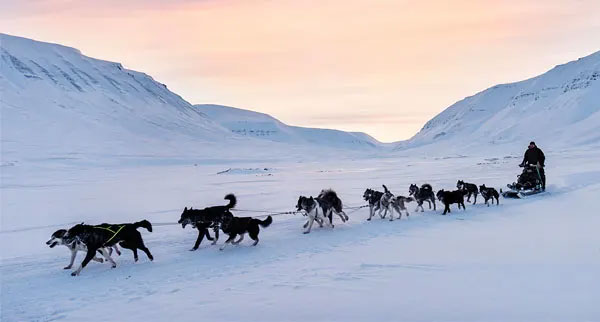
Husky high
Snowmobiles are the vehicle of choice around here, and are used for other tours from Longyearbyen, taking in the Russian-populated town of Barentsburg or heading as far as the polar bear-filled east coast. But they are a relatively new invention compared with the husky dogs that transported the first explorers across this inhospitable terrain.
The howls of excitable huskies filled the air as we arrived at Green Dog Svalbard, a family-run outfit just outside Longyearbyen, offering husky-sledding adventures lasting anything from three hours to three days.
“The only sounds came from the panting dogs as they sprinted flat out, paws pounding the powdery snow and harnesses jingling like sleigh bells.”
We kitted ourselves out in thermal suits, boots, mittens and hats, then harnessed our team of six dogs to the simple sled. With one person sitting in front and another standing at the back operating the all-important ‘brake’ – perhaps the most indispensable piece of equipment, as these dogs are ready to race as soon as they get the chance – we set off into the snowy wilderness.
Without the thrum of a snowmobile engine, the only sounds came from the panting dogs as they sprinted flat out, paws pounding the powdery snow and harnesses jingling like sleigh bells, while the snowy scenery whizzed by. The journey was over before we knew it as we arrived at Juva Cabin, a simple chalet set in total isolation, with no other buildings for miles. In fact, it was so remote that returning to Longyearbyen the next day felt like going back to the big smoke.
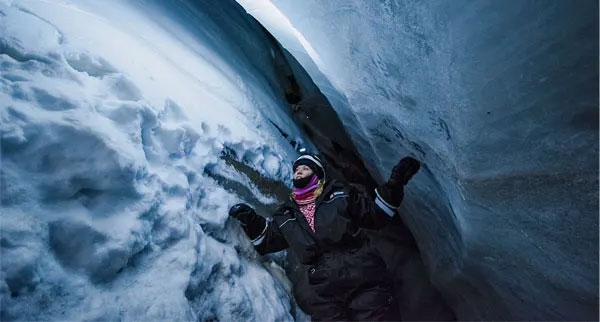
Cave caper
Having spent time exploring on land and atop glaciers, tour final adventure took us deep below the surface to explore an ice cave.
After a 20-minute journey by snowcat from Longyearbyen, we came to a small opening in the ice, with a ladder peeking out above the edge. It’s not nearly as claustrophobic as it might sound, though. Clamber down and it’s surprisingly roomy, with more than enough space to stand upright and admire its cavernous ceilings, see long diagonal streams of grit and stones frozen in time by the flow of the glacier, and spot the tiny bubbles of air captured inside the ice for hundreds, maybe even thousands, of years.
“Clamber down and it’s surprisingly roomy, with more than enough space to stand upright and admire its cavernous ceilings.”
It’s a tiny but tangible link back to the days of the earliest pioneers, when Dutch navigator Willem Barentsz stumbled across Spitsbergen in 1596 while searching for a trading route to China, lighting the spark for centuries of whaling, mining and Arctic exploration. Now, there’s far more focus on protecting this unique environment, preserving the islands for the wildlife – and the people – who make their home here, right on the edge of the inhabited world.
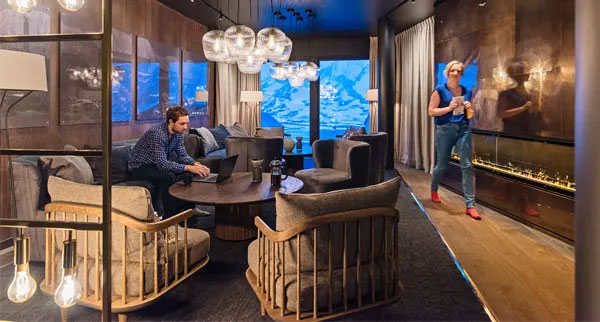
Tried and tested: Funken Lodge, Longyearbyen
This 88-room property, set in the former officers’ mess of Spitsbergen’s coal mining company, reopened last year after a refurbishment turned it into Svalbard’s most luxurious property. Its slick, modern design and supremely comfortable rooms still pay homage to its history, with photos of headlamp-wearing miners, and a cosy library stocked with books about Svalbard.
The fine-dining restaurant offers surprisingly accomplished dishes for such a remote location – and an even more lavish wine list – with panoramic windows framing stunning landscapes.There’s a small gym and sauna, and bar and lounge areas decorated in a muted palette of stone greys and neutral browns – perfect for relaxing and swapping stories with fellow explorers.
Fellow Longyearbyen property the Radisson Blu Polar Hotel Spitsbergen has also been refurbished this year.
Read more
Where to go whale watching in Canada
Expedition cruise: Bucket-list adventures
Off the beaten track in Chile, South America


